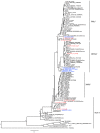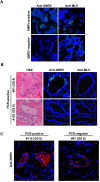No evidence of XMRV in prostate cancer cohorts in the Midwestern United States
- PMID: 21447170
- PMCID: PMC3077333
- DOI: 10.1186/1742-4690-8-23
No evidence of XMRV in prostate cancer cohorts in the Midwestern United States
Abstract
Background: Xenotropic murine leukemia virus (MLV)-related virus (XMRV) was initially identified in prostate cancer (PCa) tissue, particularly in the prostatic stromal fibroblasts, of patients homozygous for the RNASEL R462Q mutation. A subsequent study reported XMRV antigens in malignant prostatic epithelium and association of XMRV infection with PCa, especially higher-grade tumors, independently of the RNASEL polymorphism. Further studies showed high prevalence of XMRV or related MLV sequences in chronic fatigue syndrome patients (CFS), while others found no, or low, prevalence of XMRV in a variety of diseases including PCa or CFS. Thus, the etiological link between XMRV and human disease remains elusive. To address the association between XMRV infection and PCa, we have tested prostate tissues and human sera for the presence of viral DNA, viral antigens and anti-XMRV antibodies.
Results: Real-time PCR analysis of 110 PCa (Gleason scores >4) and 40 benign and normal prostate tissues identified six positive samples (5 PCa and 1 non-PCa). No statistical link was observed between the presence of proviral DNA and PCa, PCa grades, and the RNASEL R462Q mutation. The amplified viral sequences were distantly related to XMRV, but nearly identical to endogenous MLV sequences in mice. The PCR positive samples were also positive for mouse mitochondrial DNA by nested PCR, suggesting contamination of the samples with mouse DNA. Immuno-histochemistry (IHC) with an anti-XMRV antibody, but not an anti-MLV antibody that recognizes XMRV, sporadically identified antigen-positive cells in prostatic epithelium, irrespectively of the status of viral DNA detection. No serum (159 PCa and 201 age-matched controls) showed strong neutralization of XMRV infection at 1:10 dilution.
Conclusion: The lack of XMRV sequences or strong anti-XMRV neutralizing antibodies indicates no or very low prevalence of XMRV in our cohorts. We conclude that real-time PCR- and IHC-positive samples were due to laboratory contamination and non-specific immune reactions, respectively.
Figures




Similar articles
-
No association between XMRV or related gammaretroviruses in Australian prostate cancer patients.Virol J. 2013 Jan 10;10:20. doi: 10.1186/1743-422X-10-20. Virol J. 2013. PMID: 23305518 Free PMC article.
-
Contamination of human DNA samples with mouse DNA can lead to false detection of XMRV-like sequences.Retrovirology. 2010 Dec 20;7:109. doi: 10.1186/1742-4690-7-109. Retrovirology. 2010. PMID: 21171973 Free PMC article.
-
No association of xenotropic murine leukemia virus-related viruses with prostate cancer.PLoS One. 2011 May 4;6(5):e19065. doi: 10.1371/journal.pone.0019065. PLoS One. 2011. PMID: 21573232 Free PMC article.
-
Lack of evidence for a role of xenotropic murine leukemia virus-related virus in the pathogenesis of prostate cancer and/or chronic fatigue syndrome.Virus Res. 2012 Jul;167(1):1-7. doi: 10.1016/j.virusres.2012.04.004. Epub 2012 Apr 15. Virus Res. 2012. PMID: 22531412 Review.
-
False Alarm: XMRV, Cancer, and Chronic Fatigue Syndrome.Annu Rev Virol. 2024 Sep;11(1):261-281. doi: 10.1146/annurev-virology-111821-125122. Epub 2024 Aug 30. Annu Rev Virol. 2024. PMID: 38976866 Review.
Cited by
-
No association between XMRV or related gammaretroviruses in Australian prostate cancer patients.Virol J. 2013 Jan 10;10:20. doi: 10.1186/1743-422X-10-20. Virol J. 2013. PMID: 23305518 Free PMC article.
-
Infection of Xenotransplanted Human Cell Lines by Murine Retroviruses: A Lesson Brought Back to Light by XMRV.Front Oncol. 2013 Jun 17;3:156. doi: 10.3389/fonc.2013.00156. eCollection 2013. Front Oncol. 2013. PMID: 23785669 Free PMC article.
-
No detection of XMRV in blood samples and tissue sections from prostate cancer patients in Northern Europe.PLoS One. 2011;6(10):e25592. doi: 10.1371/journal.pone.0025592. Epub 2011 Oct 12. PLoS One. 2011. PMID: 22022417 Free PMC article.
-
No evidence of murine leukemia virus-related viruses in live attenuated human vaccines.PLoS One. 2011;6(12):e29223. doi: 10.1371/journal.pone.0029223. Epub 2011 Dec 22. PLoS One. 2011. PMID: 22216219 Free PMC article.
-
Absence of XMRV in peripheral blood mononuclear cells of ARV-treatment naïve HIV-1 infected and HIV-1/HCV coinfected individuals and blood donors.PLoS One. 2012;7(2):e31398. doi: 10.1371/journal.pone.0031398. Epub 2012 Feb 13. PLoS One. 2012. PMID: 22348082 Free PMC article.
References
-
- Urisman A, Molinaro RJ, Fischer N, Plummer SJ, Casey G, Klein EA, Malathi K, Magi-Galluzzi C, Tubbs RR, Ganem D. et al.Identification of a novel Gammaretrovirus in prostate tumors of patients homozygous for R462Q RNASEL variant. PLoS Pathog. 2006;2:e25. doi: 10.1371/journal.ppat.0020025. - DOI - PMC - PubMed
Publication types
MeSH terms
Substances
Grants and funding
LinkOut - more resources
Full Text Sources
Other Literature Sources
Medical
Research Materials

